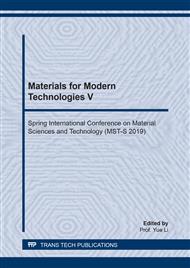p.174
p.180
p.194
p.200
p.207
p.214
p.221
p.231
p.238
Effect of Calcined-Bauxite Quality and Secondary Mullitization Reaction on Firing and Properties of Ceramic Plates
Abstract:
Addition of different types of calcined bauxites to the ceramic plate formulation was performed to study effects on the firing and properties of the resulting ceramic plates. The physical and chemical characteristics, high-temperature reaction degree, thermochemical behavior, mineral composition, and microstructure of the calcined bauxites were analyzed. The results showed that lightly calcined bauxite could minimize the linear shrinkage rate. However, incomplete high-temperature secondary mullitization reaction could inhibit completion of product sintering and result in a loose microstructure, high water absorption index, and low modulus of rupture. Application of GAL-85 high-temperature calcined bauxite yielded a product with good sintering performance and low water absorption; increased amounts of mullite reinforcement phase also increased the strength of the plate. The degree of secondary mullitization was the main factor affecting the performance of the ceramic plate.
Info:
Periodical:
Pages:
207-213
Citation:
Online since:
June 2019
Authors:
Price:
Сopyright:
© 2019 Trans Tech Publications Ltd. All Rights Reserved
Share:
Citation:


